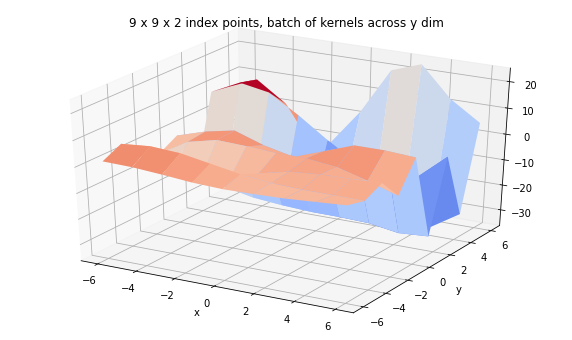此笔记本的目的是通过一些小片段帮助 TFP 0.11.0 “栩栩如生” - 您可以使用 TFP 实现的一些小演示。
 在 TensorFlow.org 上查看 在 TensorFlow.org 上查看
|
 在 Google Colab 中运行 在 Google Colab 中运行
|
 在 GitHub 上查看源代码 在 GitHub 上查看源代码
|
 下载笔记本 下载笔记本
|
安装和导入
/usr/local/lib/python3.6/dist-packages/statsmodels/tools/_testing.py:19: FutureWarning: pandas.util.testing is deprecated. Use the functions in the public API at pandas.testing instead. import pandas.util.testing as tm
TFP 可以在 JAX 上运行
_注意,这已在 nightly 构建中移至 tfp.substrates。_
import jax
from jax import config
config.update('jax_enable_x64', True)
def demo_jax():
import tensorflow_probability.substrates.jax as tfp
tfd = tfp.distributions
tfb = tfp.bijectors
@jax.jit
def vmap_sample(seeds):
d = tfb.Shift(2.)(tfb.Scale(2.)(tfd.Normal(0, 1)))
return jax.vmap(lambda seed: d.sample(seed=seed))(seeds)
def vmap_grad(seeds, sh, sc):
d = lambda sh, sc: tfb.Shift(sh)(tfb.Scale(sc)(tfd.Normal(0, 1)))
return jax.vmap(
jax.grad(lambda sh, sc, samp: d(sh, sc).log_prob(samp),
argnums=(0,1,2)),
in_axes=(None, None, 0))(sh, sc, vmap_sample(seeds))
seed = jax.random.PRNGKey(123)
seeds = jax.random.split(seed, 10)
print('jit vmap sample:', vmap_sample(seeds))
print('vmap grad:', vmap_grad(seeds, 2., 2.))
@jax.jit
def hmm_sample(seed):
init, transition, obsv, sample = jax.random.split(seed, num=4)
d = tfd.HiddenMarkovModel(
initial_distribution=tfd.Categorical(logits=jax.random.uniform(init, [3]) + .1),
transition_distribution=tfd.Categorical(logits=jax.random.uniform(transition, [3, 3]) + .1),
observation_distribution=tfd.Normal(loc=jax.random.normal(obsv, [3]), scale=1.),
num_steps=10)
samps = d.sample(seed=sample)
return samps, d.log_prob(samps)
print('hmm:', hmm_sample(jax.random.PRNGKey(123)))
@jax.jit
def nuts(seed):
return tfp.mcmc.sample_chain(
num_results=10,
num_burnin_steps=50,
current_state=np.zeros([75]),
kernel=tfp.mcmc.NoUTurnSampler(
target_log_prob_fn=lambda x: -(x - .2)**2 / .05,
step_size=.1),
trace_fn=None,
seed=seed)
print('nuts:')
plt.hist(nuts(seed=jax.random.PRNGKey(7)).reshape(-1), bins=20, density=True)
demo_jax()
/usr/local/lib/python3.6/dist-packages/jax/lib/xla_bridge.py:125: UserWarning: No GPU/TPU found, falling back to CPU.
warnings.warn('No GPU/TPU found, falling back to CPU.')
jit vmap sample: [ 2.17746 2.6618252 3.427014 -0.80979496 5.87146 4.2002716
1.2994273 1.2281269 3.5244293 4.1996603 ]
/usr/local/lib/python3.6/dist-packages/jax/numpy/lax_numpy.py:1531: FutureWarning: jax.numpy reductions won't accept lists and tuples in future versions, only scalars and ndarrays
warnings.warn(msg, category=FutureWarning)
vmap grad: (DeviceArray([ 0.04436499, 0.1654563 , 0.35675353, -0.70244873,
0.96786499, 0.5500679 , -0.17514318, -0.19296828,
0.38110733, 0.54991508], dtype=float64), DeviceArray([-0.4960635 , -0.44524843, -0.24545383, 0.48686844,
1.37352526, 0.10514939, -0.43864973, -0.42552648,
-0.20951441, 0.10481316], dtype=float64), DeviceArray([-0.04436499, -0.1654563 , -0.35675353, 0.7024487 ,
-0.967865 , -0.5500679 , 0.17514318, 0.19296828,
-0.38110733, -0.5499151 ], dtype=float32))
hmm: (DeviceArray([-0.30260671, -0.38072154, 0.57980393, -0.30949971,
1.22571819, -1.72733693, -1.13891736, -0.05021395,
0.33300565, -0.31721795], dtype=float64), DeviceArray(-12.69673571, dtype=float64))
nuts:
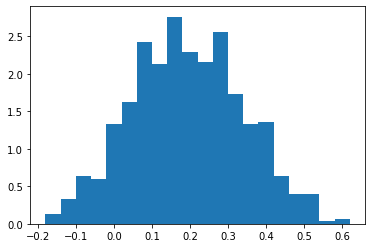
使用顺序蒙特卡罗进行推理(实验性)
nmodes = 7
loc_prior = tfd.MultivariateNormalDiag(loc=[0, 0], scale_diag=[2, 2])
mode_locs = loc_prior.sample(nmodes, seed=(0, 1))
logits_prior = tfd.Uniform()
mode_logits = logits_prior.sample(nmodes, seed=(0, 2))
make_mvn = lambda locs: tfd.MultivariateNormalDiag(
loc=locs, scale_diag=tf.ones_like(locs))
make_mixture = lambda locs, logits: tfd.MixtureSameFamily(
mixture_distribution=tfd.Categorical(logits=logits),
components_distribution=make_mvn(locs))
true_dist = make_mixture(mode_locs, mode_logits)
from mpl_toolkits import mplot3d
x = np.linspace(-6, 6, 100)
y = np.linspace(-6, 6, 100)
X, Y = np.asarray(np.meshgrid(x, y), dtype=np.float32)
Z = true_dist.prob(tf.stack([X, Y], axis=-1))
fig = plt.figure(figsize=(10, 6))
ax = plt.axes(projection='3d')
ax.plot_surface(
X, Y, Z, rstride=1, cstride=1, cmap='coolwarm', edgecolor='none')
plt.title('source distribution')
plt.show()
data_size = 256
samps = true_dist.sample(data_size, seed=(0, 3))
sns.kdeplot(*samps.numpy().T)
plt.scatter(*samps.numpy().T)
plt.title('data')
plt.show()
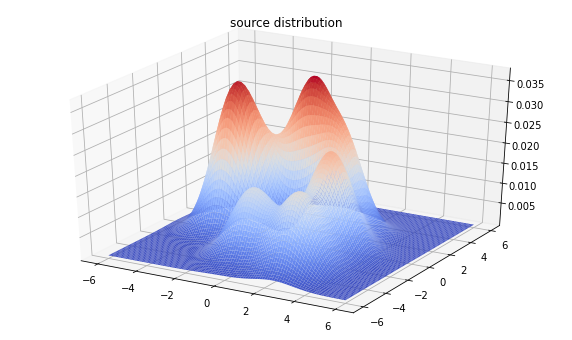
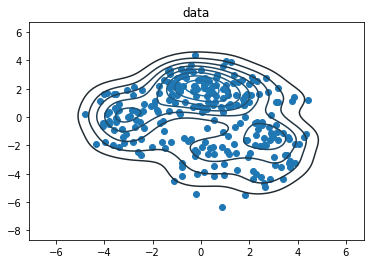
nparticles = 2048
seed = ()
(n_stage, final_state, final_kernel_results
) = tfp.experimental.mcmc.sample_sequential_monte_carlo(
prior_log_prob_fn=lambda locs, logits: (
tf.reduce_sum(loc_prior.log_prob(locs)) +
tf.reduce_sum(logits_prior.log_prob(logits))),
likelihood_log_prob_fn=lambda locs, logits: (
tfd.Sample(make_mixture(locs, logits), data_size).log_prob(samps)),
current_state=(loc_prior.sample([nparticles, nmodes + 2]),
logits_prior.sample([nparticles, nmodes + 2])),
)
# Identify any issues with particle weight collapse.
plt.figure(figsize=(5,2))
plt.plot(tf.sort(final_kernel_results.particle_info.tempered_log_prob));
plt.title(f'Sampling done in {n_stage} stage');
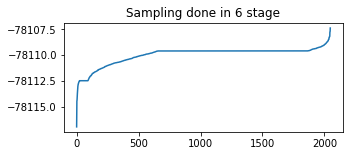
sampled_distributions = tfd.MixtureSameFamily(
mixture_distribution=tfd.Categorical(
logits=final_kernel_results.particle_info.tempered_log_prob),
components_distribution=make_mixture(*final_state),
name='ensembled_posterior')
print(sampled_distributions)
Z = sampled_distributions.prob(tf.stack([X, Y], axis=-1))
fig = plt.figure(figsize=(10, 6))
ax = plt.axes(projection='3d')
ax.plot_surface(
X, Y, Z, rstride=1, cstride=1, cmap='coolwarm', edgecolor='none')
plt.title('Ensembled posterior probability density')
plt.show()
samps2 = sampled_distributions.sample(256, seed=(0, 4))
sns.kdeplot(*samps2.numpy().T)
# sns.kdeplot(*samps.numpy().T)
plt.scatter(*samps2.numpy().T, alpha=.5, label='new samples')
plt.scatter(*samps.numpy().T, alpha=.5, label='observed')
plt.legend()
plt.title('samples from ensembled posterior')
plt.show()
tfp.distributions.MixtureSameFamily("ensembled_posterior", batch_shape=[], event_shape=[2], dtype=float32)
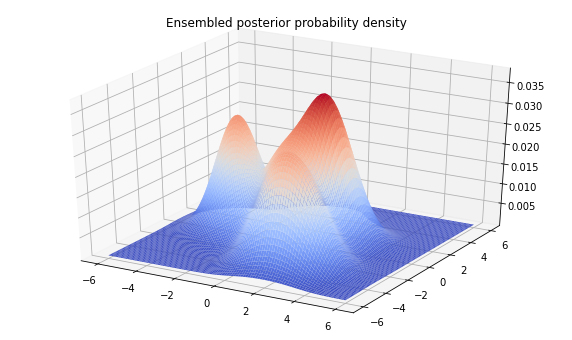
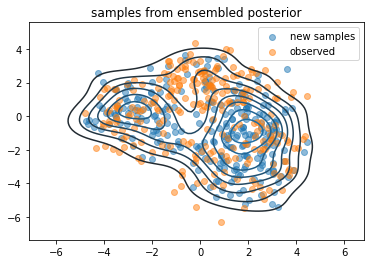
球面分布:SphericalUniform(新)、PowerSpherical(新)、VonMisesFisher
plot_spherical
在 3 维中可视化 tfd.SphericalUniform
在 3 维中可视化 tfd.PowerSpherical
在 3 维中可视化 tfd.VonMisesFisher
新的双射器
tfb.Sinh
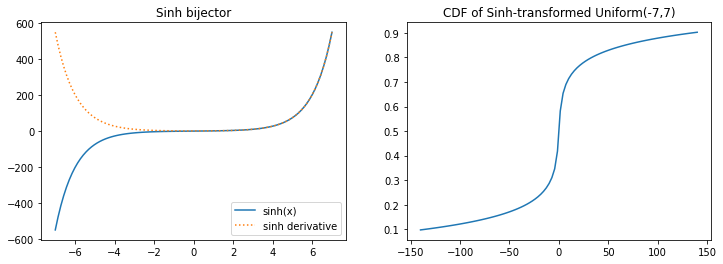
tfb.GompertzCDF
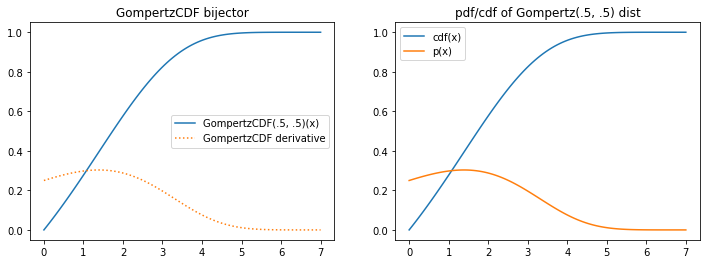
新的分布
tfd.TruncatedCauchy
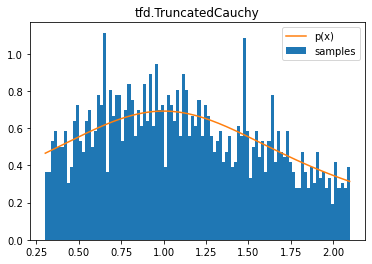
tfd.Bates(n 个均匀样本的均值)
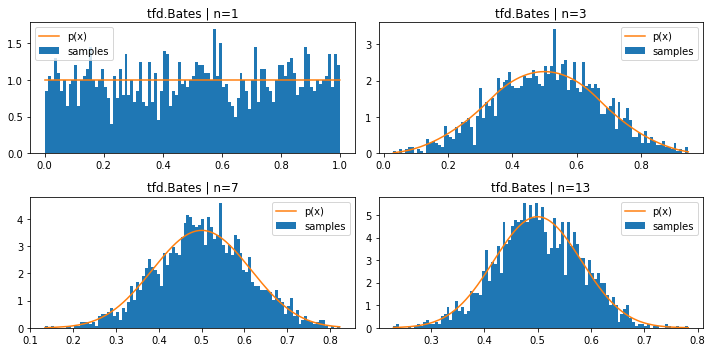
tfd.LogLogistic
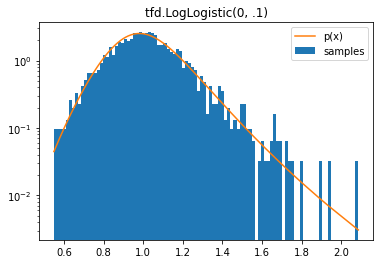
tfd.JohnsonSU

tfd.ContinuousBernoulli
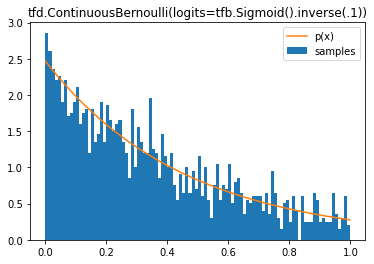
tfd.Weibull
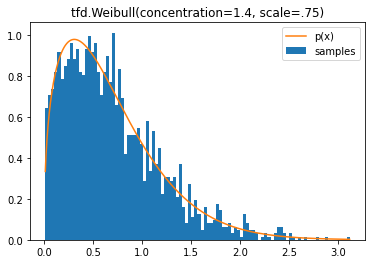
使用 JointDistribution*AutoBatched 进行自动矢量化采样
如果您曾经在联合分布中难以正确对齐批次维度,那么这适合您。
您是否曾经编写过这样的代码?
data = tf.random.stateless_normal([7], seed=(1,2))
@tfd.JointDistributionCoroutine
def model():
root = tfd.JointDistributionCoroutine.Root
scale = yield root(tfd.Gamma(1, 1, name='scale'))
yield tfd.Normal(tf.zeros_like(data), scale)
model.sample()
(<tf.Tensor: shape=(), dtype=float32, numpy=4.1253977>,
<tf.Tensor: shape=(7,), dtype=float32, numpy=
array([-2.814606 , 0.81064916, -1.1025742 , -1.8684998 , -2.9547117 ,
-0.19623983, -0.15587877], dtype=float32)>)
然后在绘制非标量样本时遇到异常?
print(model.sample(1), '\n (^^ silent badness: the second value lacks a leading (1,) shape)')
print('sampling (3,) will break:')
import traceback
try:
model.sample(3)
except ValueError as e:
traceback.print_exc()
(<tf.Tensor: shape=(1,), dtype=float32, numpy=array([0.15810375], dtype=float32)>, <tf.Tensor: shape=(7,), dtype=float32, numpy=
array([-0.03214252, 0.15187298, -0.08423525, -0.03807954, 0.25466064,
-0.14433853, 0.2543037 ], dtype=float32)>)
(^^ silent badness: the second value lacks a leading (1,) shape)
sampling (3,) will break:
Traceback (most recent call last):
File "/usr/local/lib/python3.6/dist-packages/tensorflow_probability/python/distributions/normal.py", line 243, in _parameter_control_dependencies
self._batch_shape()
File "/usr/local/lib/python3.6/dist-packages/tensorflow_probability/python/distributions/normal.py", line 176, in _batch_shape
return tf.broadcast_static_shape(self.loc.shape, self.scale.shape)
File "/usr/local/lib/python3.6/dist-packages/tensorflow/python/util/dispatch.py", line 201, in wrapper
return target(*args, **kwargs)
File "/usr/local/lib/python3.6/dist-packages/tensorflow/python/ops/array_ops.py", line 554, in broadcast_static_shape
return common_shapes.broadcast_shape(shape_x, shape_y)
File "/usr/local/lib/python3.6/dist-packages/tensorflow/python/framework/common_shapes.py", line 107, in broadcast_shape
% (shape_x, shape_y))
ValueError: Incompatible shapes for broadcasting: (7,) and (3,)
During handling of the above exception, another exception occurred:
Traceback (most recent call last):
File "<ipython-input-28-ab2fdd83415c>", line 4, in <module>
model.sample(3)
File "/usr/local/lib/python3.6/dist-packages/tensorflow_probability/python/distributions/distribution.py", line 939, in sample
return self._call_sample_n(sample_shape, seed, name, **kwargs)
File "/usr/local/lib/python3.6/dist-packages/tensorflow_probability/python/distributions/joint_distribution.py", line 532, in _call_sample_n
**kwargs)
File "/usr/local/lib/python3.6/dist-packages/tensorflow_probability/python/internal/distribution_util.py", line 1324, in _fn
return fn(*args, **kwargs)
File "/usr/local/lib/python3.6/dist-packages/tensorflow_probability/python/distributions/joint_distribution.py", line 414, in _sample_n
**kwargs)
File "/usr/local/lib/python3.6/dist-packages/tensorflow_probability/python/distributions/joint_distribution.py", line 451, in _call_flat_sample_distributions
ds, xs = self._flat_sample_distributions(sample_shape, seed, value)
File "/usr/local/lib/python3.6/dist-packages/tensorflow_probability/python/distributions/joint_distribution_coroutine.py", line 278, in _flat_sample_distributions
d = gen.send(next_value)
File "<ipython-input-19-d59a243cd9c8>", line 7, in model
yield tfd.Normal(tf.zeros_like(data), scale)
File "<decorator-gen-306>", line 2, in __init__
File "/usr/local/lib/python3.6/dist-packages/tensorflow_probability/python/distributions/distribution.py", line 334, in wrapped_init
default_init(self_, *args, **kwargs)
File "/usr/local/lib/python3.6/dist-packages/tensorflow_probability/python/distributions/normal.py", line 148, in __init__
name=name)
File "/usr/local/lib/python3.6/dist-packages/tensorflow_probability/python/distributions/distribution.py", line 552, in __init__
d for d in self._parameter_control_dependencies(is_init=True)
File "/usr/local/lib/python3.6/dist-packages/tensorflow_probability/python/distributions/normal.py", line 248, in _parameter_control_dependencies
self.loc.shape, self.scale.shape))
ValueError: Arguments `loc` and `scale` must have compatible shapes; loc.shape=(7,), scale.shape=(3,).
现在,您可以使用 tfd.JointDistributionCoroutineAutoBatched 及其朋友
您编写一个“标量”采样例程,然后绘制任意样本形状。
@tfd.JointDistributionCoroutineAutoBatched
def model_auto():
scale = yield tfd.Gamma(1, 1, name='scale')
yield tfd.Normal(tf.zeros_like(data), scale)
print(model_auto.sample(), '\n (scalar sample)')
print(model_auto.sample(1), '\n ((1,) sample)')
print(model_auto.sample(3), '\n ((3,) sample)')
(<tf.Tensor: shape=(), dtype=float32, numpy=1.5234255>, <tf.Tensor: shape=(7,), dtype=float32, numpy=
array([-0.7177643 , -2.7825186 , -1.1250918 , 0.57446253, -1.0755515 ,
2.6673915 , -1.776087 ], dtype=float32)>)
(scalar sample)
WARNING:tensorflow:Note that RandomUniformInt inside pfor op may not give same output as inside a sequential loop.
WARNING:tensorflow:Note that RandomUniformInt inside pfor op may not give same output as inside a sequential loop.
WARNING:tensorflow:Note that RandomStandardNormal inside pfor op may not give same output as inside a sequential loop.
WARNING:tensorflow:Note that RandomStandardNormal inside pfor op may not give same output as inside a sequential loop.
(<tf.Tensor: shape=(1,), dtype=float32, numpy=array([0.48698178], dtype=float32)>, <tf.Tensor: shape=(1, 7), dtype=float32, numpy=
array([[ 0.44244727, -0.548889 , 0.29392514, -0.5249126 , -0.6618264 ,
0.06925056, -0.32040703]], dtype=float32)>)
((1,) sample)
WARNING:tensorflow:Note that RandomUniformInt inside pfor op may not give same output as inside a sequential loop.
WARNING:tensorflow:Note that RandomUniformInt inside pfor op may not give same output as inside a sequential loop.
WARNING:tensorflow:Note that RandomStandardNormal inside pfor op may not give same output as inside a sequential loop.
WARNING:tensorflow:Note that RandomStandardNormal inside pfor op may not give same output as inside a sequential loop.
(<tf.Tensor: shape=(3,), dtype=float32, numpy=array([0.5501703, 1.9277483, 2.7804365], dtype=float32)>, <tf.Tensor: shape=(3, 7), dtype=float32, numpy=
array([[-1.1568309 , 0.02062727, 0.04918252, -0.08978909, 0.6446161 ,
-0.16725235, -0.27897784],
[-2.9246418 , -1.2733852 , 1.0071639 , -0.4655921 , -4.1095695 ,
0.1298227 , 3.0307395 ],
[-2.7411313 , 1.6211014 , -1.600051 , -1.4009917 , 4.081262 ,
1.7097493 , 2.8525631 ]], dtype=float32)>)
((3,) sample)
可重复采样,即使在 eager 中也是如此
tf.random.set_seed(123)
print('Stateful sampling:\t\t',
tfd.Normal(0, 1).sample(seed=234),
'then',
tfd.Normal(0, 1).sample(seed=234))
# Why are they different?
# TF samplers are stateful by default (TF maintains is a global PRNG).
# How to get reproducible results in eager mode?
tf.random.set_seed(123)
print('Stateful sampling (set_seed):\t',
tfd.Normal(0, 1).sample(seed=234))
# And what about tf.function?
@tf.function
def sample_normal():
return tfd.Normal(0, 1).sample(seed=234)
tf.random.set_seed(123)
print('tf.function:\t\t', sample_normal(), 'vs', sample_normal())
tf.random.set_seed(123)
print('tf.function (set_seed):\t', sample_normal())
# Using a Tensor seed (or a tuple, which TFP will convert to a tensor) induces
# TFP behavior analagous to the tf.random.stateless_* ops. This sampling
# is fully deterministic.
print('Stateless sampling (tuple):\t\t',
tfd.Normal(0, 1).sample(seed=(1, 23)))
print('Stateless sampling (tensor):\t\t',
tfd.Normal(0, 1).sample(seed=tf.constant([1, 23], dtype=tf.int32)))
# Even in tf.function
@tf.function
def sample_normal():
return tfd.Normal(0, 1).sample(seed=(1, 23))
print('Stateless sampling (tf.function):\t', sample_normal())
# And independent of global seeds.
tf.random.set_seed(321)
print('Stateless sampling (ignores set_seed):\t', sample_normal())
Stateful sampling: tf.Tensor(0.54054874, shape=(), dtype=float32) then tf.Tensor(-1.5518123, shape=(), dtype=float32) Stateful sampling (set_seed): tf.Tensor(0.54054874, shape=(), dtype=float32) tf.function: tf.Tensor(0.54054874, shape=(), dtype=float32) vs tf.Tensor(-1.5518123, shape=(), dtype=float32) tf.function (set_seed): tf.Tensor(0.54054874, shape=(), dtype=float32) Stateless sampling (tuple): tf.Tensor(-0.36107817, shape=(), dtype=float32) Stateless sampling (tensor): tf.Tensor(-0.36107817, shape=(), dtype=float32) Stateless sampling (tf.function): tf.Tensor(-0.36107817, shape=(), dtype=float32) Stateless sampling (ignores set_seed): tf.Tensor(-0.36107817, shape=(), dtype=float32)
类似地,tfp.mcmc.sample_chain 现在接受无状态种子
这将传递给底层内核,如果它们进行随机提议,则必须更新这些内核以接受 seed 参数到 one_step。(内置内核已更新。)
kernel = tfp.mcmc.HamiltonianMonteCarlo(lambda x: -(x - .2)**2,
step_size=1.,
num_leapfrog_steps=2)
print_n_lines = lambda x, n: print('\n'.join(repr(x).split('\n')[:n] + ['...']))
print_n_lines(
tfp.mcmc.sample_chain(
num_results=5,
num_burnin_steps=100,
current_state=tf.zeros([3]),
kernel=kernel,
trace_fn=lambda state, kr: kr,
seed=(1, 2)),
17)
print('And again (reproducibly)...')
print_n_lines(
tfp.mcmc.sample_chain(
num_results=5,
num_burnin_steps=100,
current_state=tf.zeros([3]),
kernel=kernel,
trace_fn=lambda state, kr: kr,
seed=(1, 2)),
17)
StatesAndTrace(
all_states=<tf.Tensor: shape=(5, 3), dtype=float32, numpy=
array([[ 4.0000078e-01, 3.9999962e-01, 3.9999855e-01],
[-8.3446503e-07, 3.5762787e-07, 1.5497208e-06],
[ 4.0000081e-01, 3.9999965e-01, 3.9999846e-01],
[-8.3446503e-07, 4.7683716e-07, 1.5497208e-06],
[ 4.0000087e-01, 3.9999962e-01, 3.9999843e-01]], dtype=float32)>,
trace=MetropolisHastingsKernelResults(
accepted_results=UncalibratedHamiltonianMonteCarloKernelResults(
log_acceptance_correction=<tf.Tensor: shape=(5, 3), dtype=float32, numpy=
array([[ 0.0000000e+00, -2.9802322e-08, 0.0000000e+00],
[ 5.9604645e-08, 1.1175871e-08, 1.1920929e-07],
[-2.9802322e-08, -2.7939677e-09, 2.7939677e-09],
[ 0.0000000e+00, 0.0000000e+00, -5.9604645e-08],
[ 1.4901161e-08, -1.7881393e-07, 0.0000000e+00]], dtype=float32)>,
target_log_prob=<tf.Tensor: shape=(5, 3), dtype=float32, numpy=
array([[-0.04000031, -0.03999985, -0.03999942],
...
And again (reproducibly)...
StatesAndTrace(
all_states=<tf.Tensor: shape=(5, 3), dtype=float32, numpy=
array([[ 4.0000078e-01, 3.9999962e-01, 3.9999855e-01],
[-8.3446503e-07, 3.5762787e-07, 1.5497208e-06],
[ 4.0000081e-01, 3.9999965e-01, 3.9999846e-01],
[-8.3446503e-07, 4.7683716e-07, 1.5497208e-06],
[ 4.0000087e-01, 3.9999962e-01, 3.9999843e-01]], dtype=float32)>,
trace=MetropolisHastingsKernelResults(
accepted_results=UncalibratedHamiltonianMonteCarloKernelResults(
log_acceptance_correction=<tf.Tensor: shape=(5, 3), dtype=float32, numpy=
array([[ 0.0000000e+00, -2.9802322e-08, 0.0000000e+00],
[ 5.9604645e-08, 1.1175871e-08, 1.1920929e-07],
[-2.9802322e-08, -2.7939677e-09, 2.7939677e-09],
[ 0.0000000e+00, 0.0000000e+00, -5.9604645e-08],
[ 1.4901161e-08, -1.7881393e-07, 0.0000000e+00]], dtype=float32)>,
target_log_prob=<tf.Tensor: shape=(5, 3), dtype=float32, numpy=
array([[-0.04000031, -0.03999985, -0.03999942],
...
漂亮打印 MCMC 内核结果
tfp.mcmc.RandomWalkMetropolis(tfd.Uniform(0, 10).log_prob).bootstrap_results(1.)
MetropolisHastingsKernelResults(
accepted_results=UncalibratedRandomWalkResults(
log_acceptance_correction=<tf.Tensor: shape=(), dtype=float32, numpy=0.0>,
target_log_prob=<tf.Tensor: shape=(), dtype=float32, numpy=-2.3025851>,
seed=[]
),
is_accepted=<tf.Tensor: shape=(), dtype=bool, numpy=True>,
log_accept_ratio=<tf.Tensor: shape=(), dtype=float32, numpy=0.0>,
proposed_state=1.0,
proposed_results=UncalibratedRandomWalkResults(
log_acceptance_correction=<tf.Tensor: shape=(), dtype=float32, numpy=0.0>,
target_log_prob=<tf.Tensor: shape=(), dtype=float32, numpy=-2.3025851>,
seed=<tf.Tensor: shape=(2,), dtype=int32, numpy=array([0, 0], dtype=int32)>
),
extra=[],
seed=<tf.Tensor: shape=(2,), dtype=int32, numpy=array([0, 0], dtype=int32)>
)
CompositeTensor(实验性)
节省跟踪 tf.function。从 tf.function 返回分布。
@tf.function
def get_mean(d):
return d.mean()
print(get_mean(tfp.experimental.as_composite(tfd.BetaBinomial(100., 2., 7.))))
@tf.function
def returns_dist(logits):
return tfp.experimental.as_composite(tfd.Binomial(10., logits=logits))
print(returns_dist(tf.constant(0.)),
returns_dist(tf.constant(0.)).sample(seed=(2, 3)))
tf.Tensor(22.222221, shape=(), dtype=float32)
tfp.distributions.BinomialCT("Binomial", batch_shape=[], event_shape=[], dtype=float32) tf.Tensor(5.0, shape=(), dtype=float32)
您知道吗:批次切片分布
def demo_batch_slice():
d = tfd.Normal(
loc=tf.random.stateless_normal([100, 20, 3], seed=(1,2)),
scale=1.)
print(d, '\n (original dist)')
print(d[0], '\n (0th element of the first batch dimension)')
print(d[::2, ..., 1], '\n (every other element of first dim x middle element of final dim)\n')
d = tfd.Dirichlet(
concentration=tf.random.stateless_uniform([100, 20, 3, 7], seed=(1,2)))
print(d, '\n (original dist)')
print(d[:, 0], '\n (0th element of the second dimension)')
print(d[::2, ..., 1], '\n (every other element of first dim x middle element of final dim)')
demo_batch_slice()
tfp.distributions.Normal("Normal", batch_shape=[100, 20, 3], event_shape=[], dtype=float32)
(original dist)
tfp.distributions.Normal("Normal", batch_shape=[20, 3], event_shape=[], dtype=float32)
(0th element of the first batch dimension)
tfp.distributions.Normal("Normal", batch_shape=[50, 20], event_shape=[], dtype=float32)
(every other element of first dim x middle element of final dim)
tfp.distributions.Dirichlet("Dirichlet", batch_shape=[100, 20, 3], event_shape=[7], dtype=float32)
(original dist)
tfp.distributions.Dirichlet("Dirichlet", batch_shape=[100, 3], event_shape=[7], dtype=float32)
(0th element of the second dimension)
tfp.distributions.Dirichlet("Dirichlet", batch_shape=[50, 20], event_shape=[7], dtype=float32)
(every other element of first dim x middle element of final dim)
随机新奇:采样 S 型 Cox(非齐次泊松)过程
我们可以使用 Adams 等人 提出的稀疏程序。
请注意,类似的稀疏方法与非可逆 MCMC 的某些方法(例如,锯齿形和弹性粒子采样器)相关,其中可以使用强度上限来采样非齐次事件。
def sigmoidal_cox_process():
V = 20.
lam0 = 3.
n_homog = tfd.Poisson(V * lam0).sample(seed=(0, 1))
homog_locs = tf.sort(tfd.Uniform(0., V).sample(n_homog, seed=(0, 2)))
homog_intensities = tfd.GaussianProcess(
tfpk.MaternThreeHalves(),
index_points=homog_locs[:, tf.newaxis]).sample(seed=(0, 3))
plt.figure(figsize=(15,10))
plt.title('sampling a non-homogenous poisson process')
plt.hlines(lam0, xmin=0., xmax=V)
sigm_int = tf.math.sigmoid(homog_intensities) * lam0
sp = scipy.interpolate.make_interp_spline(homog_locs, sigm_int)
xs = np.linspace(homog_locs[0], homog_locs[-1], 100)
ys = scipy.interpolate.splev(xs, sp)
plt.plot(xs, ys)
plt.scatter(homog_locs, sigm_int, s=5., c='black')
unif = tfd.Uniform(0, lam0).sample(n_homog)
plt.scatter(homog_locs, tf.where(unif < sigm_int, np.nan, unif), c='r', marker='x')
plt.scatter(homog_locs, tf.where(unif > sigm_int, np.nan, unif), c='g', marker='x')
plt.vlines(homog_locs, 0, -.07, colors='gray', )
plt.text(.8, -.06, 'homogenous', dict(fontsize='medium'), horizontalalignment='right')
nonhomog_locs = tf.gather(homog_locs, tf.where(unif < sigm_int))
plt.vlines(nonhomog_locs, -.1, -.17, colors='black')
plt.text(.8, -.16, 'thinned', dict(fontsize='medium'), horizontalalignment='right')
plt.show()
sigmoidal_cox_process()
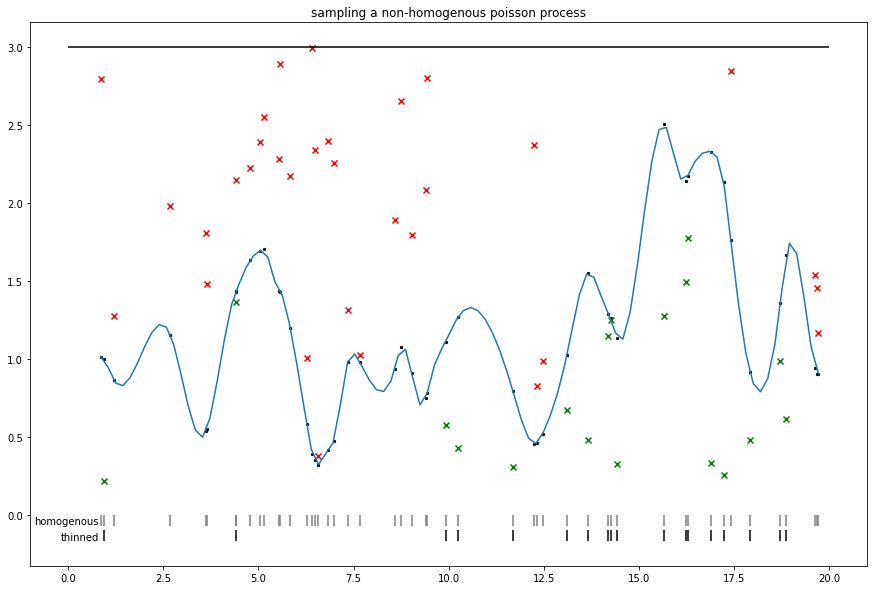
您知道吗:GP 的批次
高斯过程是函数上的分布。在这里,我们将通过内核和一组索引点进行参数化,并展示一些批处理行为。
(TFP 还支持 GP 回归模型,其中观察到的索引点处的观察结果决定了索引点集上函数的后验分布,请参阅 tfd.GaussianProcessRegressionModel。)
from mpl_toolkits import mplot3d
x = np.linspace(-6, 6, 9)
y = np.linspace(-6, 6, 9)
X, Y = np.asarray(np.meshgrid(x, y), dtype=np.float32)
print('We can set up a single GP over many examples of 2d feature')
gp = tfd.GaussianProcess(
tfpk.ExponentiatedQuadratic(length_scale=3., feature_ndims=1),
index_points=tf.reshape(tf.stack([X, Y], axis=-1), (-1, 2)),
jitter=1e-3)
print(gp)
Z = tf.reshape(gp.sample(seed=(0,3)), X.shape)
fig = plt.figure(figsize=(10, 6))
ax = plt.axes(projection='3d')
ax.plot_surface(
X, Y, Z, rstride=1, cstride=1, cmap='coolwarm', edgecolor='none');
ax.set_xlabel('x');ax.set_ylabel('y');
ax.set_title('81 x 2 index points (single GP over all pts)')
plt.show()
print('We can have a batch of independent GPs with their own sets of index points.')
batch_gp = tfd.GaussianProcess(
tfpk.ExponentiatedQuadratic(length_scale=3., feature_ndims=1),
index_points=tf.stack([X, Y], axis=-1),
jitter=1e-3)
print(batch_gp)
Z_batch = batch_gp.sample(seed=(5,7))
fig = plt.figure(figsize=(10, 6))
ax = plt.axes(projection='3d')
ax.plot_surface(
X, Y, Z_batch, rstride=1, cstride=1, cmap='coolwarm', edgecolor='none');
ax.set_xlabel('x');ax.set_ylabel('y');
ax.set_title('9 x 9 x 2 index points (9 indep GPs, one at each y position)');
plt.show()
print('We can also have a corresponding batch of kernels.')
kernel = tfpk.ExponentiatedQuadratic(length_scale=3.,
amplitude=tf.linspace(1., 20., 9),
feature_ndims=1)
print(kernel)
batch_gp_kernel = tfd.GaussianProcess(
kernel,
index_points=tf.stack([X, Y], axis=-1),
jitter=1e-3)
print(batch_gp_kernel)
Z_batch_kernel = batch_gp_kernel.sample(seed=(5,7))
fig = plt.figure(figsize=(10, 6))
ax = plt.axes(projection='3d')
ax.plot_surface(
X, Y, Z_batch_kernel, rstride=1, cstride=1, cmap='coolwarm', edgecolor='none');
ax.set_xlabel('x');ax.set_ylabel('y');
ax.set_title('9 x 9 x 2 index points, batch of kernels across y dim');
We can set up a single GP over many examples of 2d feature
tfp.distributions.GaussianProcess("GaussianProcess", batch_shape=[], event_shape=[81], dtype=float32)
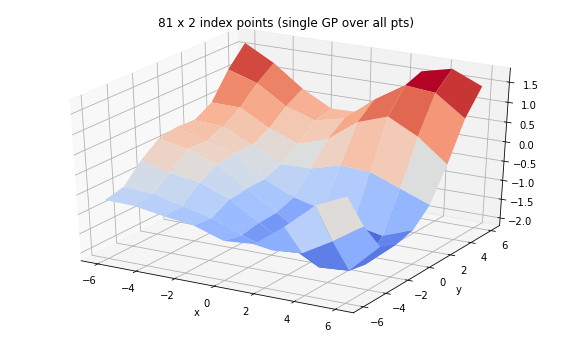
We can have a batch of independent GPs with their own sets of index points.
tfp.distributions.GaussianProcess("GaussianProcess", batch_shape=[9], event_shape=[9], dtype=float32)
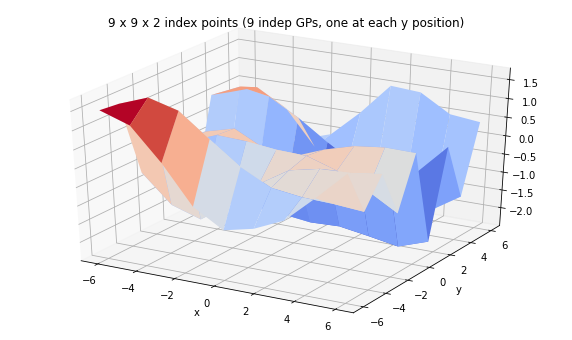
We can also have a corresponding batch of kernels.
tfp.math.psd_kernels.ExponentiatedQuadratic("ExponentiatedQuadratic", batch_shape=(9,), feature_ndims=1, dtype=float32)
tfp.distributions.GaussianProcess("GaussianProcess", batch_shape=[9], event_shape=[9], dtype=float32)
